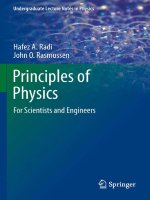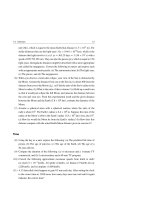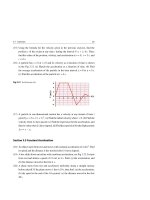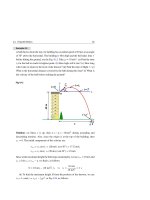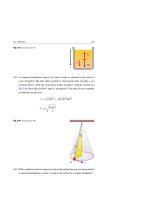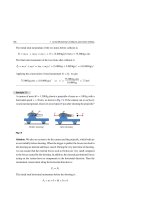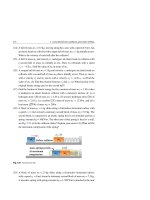Hafez a radi, john o rasmussen auth principles of physics for scientists and engineers 06
Bạn đang xem bản rút gọn của tài liệu. Xem và tải ngay bản đầy đủ của tài liệu tại đây (585.48 KB, 20 trang )
5.3 Applications to Newton’s Laws
115
In part (c) of Fig. 5.11, we first construct a free-body diagram of the stationary
knot that holds the three cords together, and then we choose the coordinate axes.
By applying Newton’s second law in the x and y directions of part (c) of the figure,
we find that:
Fx = T3 cos θ − T2 cos φ = 0
and
Fy = T3 sin θ + T2 sin φ − T1 = 0
From the x-component equation we get the following relation:
T3 =
cos φ
12/13
20
T2 =
T2 =
T2
cos θ
3/5
13
When we substitute the result of T3 into the y component equation, after putting
T1 = mg = 210 N, we get:
20 4
5
T2 + T2 − 210 = 0
13 5
13
⇒
16
5
+
T2 = 210
13 13
⇒
T2 = 130 N
Consequently, one can find the value of the third tension to be:
T3 =
20
20
T2 =
× 130 N = 200 N
13
13
Example 5.3
Two masses m1 and m2 (m2 > m1 ), are connected by a light cord that passes over a
massless, frictionless pulley as shown in part (a) of Fig. 5.12. This arrangement is
called Atwood’s machine and sometimes is used to measure the acceleration due
to gravity. Find the magnitude of acceleration of the two masses and the tension
in the cord (consider m1 = 4 kg and m2 = 6 kg).
Solution: We construct a free-body diagram for the two masses as shown in parts
(b) and (c) of Fig. 5.12. When Newton’s second law is applied to m1 in part (b) of
the figure, we find:
Fy = T − m1 g = m1 a
Also, we do the same for m2 of part (c) of the figure, to get:
Fy = m2 g − T = m2 a
116
5 Force and Motion
y
T
T
a
m1
m2
a
m1
m1 g
m2
y
(a)
m2 g
(c)
(b)
Fig. 5.12
When we add the last two equations, T will cancel out, and we get:
m2 g − m1 g = m2 a + m1 a
Thus:
a=
m2 − m1
g
m1 + m2
⇒
a=
6 kg − 4 kg
× 9.8 m/s2 = 1.96 m/s2
6 kg + 4 kg
If we substitute with a into the first equation we get:
T=
2m1 m2
g
m1 + m2
⇒
T=
2(4 kg)(6 kg)
× 9.8 m/s2 = 47 N
6 kg + 4 kg
Example 5.4
A car moving with an initial speed v◦ = 30 m/s suddenly brakes, locking its wheels
(i.e. it starts to skid). The car travels on the road a distance d = 75 m before it comes
to a complete stop. Find the coefficient of kinetic friction between the tires of the
car and the road.
Solution: Part (a) of Fig. 5.13 depicts the car’s travel. In part (b) we choose the
coordinate axes and show the car’s free-body diagram during its skid. In this part
5.3 Applications to Newton’s Laws
117
→
→
we show the car’s weight W (acting downwards), the normal force N (acting
→
perpendicularly to the road), and kinetic frictional force f k (acting to the left).
y
a
=0
o
N
x
fk
d
(a)
mg
(b)
Fig. 5.13
Applying Newton’s second law in the component form, we find that:
Fx = − f k = ma
Fy = N − mg = 0
From the last equation we get N = mg. Since f k = μk N = μk mg, then the first
equation gives:
−μk mg = ma
a = −μk g
Thus:
The negative sign means that the acceleration is to the left. Since a is constant,
we can use v 2 = v◦2 + 2ax, with v = 0 and x = d. This gives:
0 = v◦2 + 2ad = v◦2 − 2μk gd
Thus:
μk =
v◦2
(30 m/s)2
= 0.61
=
2gd
2(9.8 m/s2 )(75m)
Example 5.5
A block of mass m = 2 kg is placed on an inclined plane of angle θ = 30◦ , as
shown in Fig. 5.14. The block is released from rest at the top of the plane, where the
distance from the bottom is d = 10 m. (a) Find the magnitude of the acceleration
118
5 Force and Motion
of the block and the normal force exerted on the block. (b) How long does it take
the block to reach the bottom, and what is its speed just as it gets there?
Solution: (a) We construct a free-body diagram to this example as shown in part
→
(b) of Fig. 5.14. The only forces on the block are the weight W (acting downward)
→
and the normal force N (acting perpendicular to the inclined plane). We choose a
coordinate system with x axis parallel to the incline and y-axis perpendicular to it.
With this choice, the angle between the weight vector and the negative direction
of the y-axis equals the angle θ of the inclined plane. After that, we decompose
the weight to a component of magnitude mg cos θ along the negative y-axis and
a component of magnitude mg sin θ along the x axis. The block will slide along
the inclined plane with acceleration ax and will never leave the plane; i.e. ay = 0.
Applying Newton’s second law to the x and y components gives:
Fx = mg sin θ = m ax
Fy = N − mg cos θ = 0
y
N
θ
mg
cos
θ
d
mg
θ
ax
sin
θ
x
W=mg
(a)
(b)
Fig. 5.14
From the x-component form, we see that the acceleration along the incline is
provided by the component of the weight down the incline. By taking g = 10 m/s2 ,
we get:
ax = g sin θ = (10 m/s2 )(sin 30◦ ) = 5 m/s2
5.3 Applications to Newton’s Laws
119
Notice that when θ = 0 (i.e. when the plane is horizontal) we have ax = 0 (the
minimum acceleration value). Also, we see that when θ = 90◦ (i.e. when the
plane is vertical) the case resembles a free fall scenario, resulting in ax = g
(the maximum acceleration value).
From the y component of Newton’s second law we find N to be:
N = mg cos θ = (2 kg)(10 m/s2 )(cos 30◦ ) = 17.32 N
Also, notice that when θ = 0, we have N = mg = 20 N (its maximum value),
and when θ = 90◦ , we have N = 0 (its minimum value).
(b) Since ax = constant, we apply the equation x = vx◦ t + 21 ax t 2 to the block
with vx◦ = 0 and x = d = 10 m to get the following relation:
d=
1
ax t 2
2
Then, Solving for t and taking the positive root yields:
t=
2d
=
ax
2 × (10 m)
=2s
5 m/s2
2 + 2a x with v = 0 and
Also, we can apply the kinematics equation vx2 = vx◦
x
x◦
x = d = 10 m to get the following relation:
vx2 = 2ax d
Then, solving for vx and taking the positive root yields:
vx =
2ax d =
2(5 m/s2 )(10 m) = 10 m/s
Example 5.6
A block of mass m1 = 4 kg lying on a rough horizontal surface is connected to a
second block of mass m2 = 6 kg by a light non-stretchable cord over a massless,
frictionless pulley as shown in part (a) of Fig. 5.15. The coefficient of kinetic
friction between the block and the surface is μk = 0.5. (a) Find the magnitudes
of the acceleration of the system and the tension in the cord. (b) Find the relation
between m1 and m2 in the case when the system is on the verge of slipping.
120
5 Force and Motion
y
m1
T
y
m2
m2
a
N
fk
a
m2 g
T
x
m1
m1 g
x
(a)
(b)
(c)
Fig. 5.15
Solution: (a) Since the cord is non-stretchable, the two masses have the same
magnitude of acceleration. Consequently, we construct a free-body diagram for
the two masses as shown in parts (b) and (c) of Fig. 5.15, where we take the x axis
always along any of the body’s motion. In this case a cannot take negative values.
When Newton’s second law is applied to m2 in part (b) of the figure, we find:
(1)
Fx = m2 g − T = m2 a
Fy = 0
From (1), we can find the magnitude of the tension in terms of g and a. That is:
(2)
T = m2 g − m2 a
Doing the same for m1 (see part (c) of Fig. 5.15) we get:
(3)
Fx = T − f k = m1 a
(4)
Fy = N − m1 g = 0
Since f k = μk N, and from (4) we have N = m1 g, then:
(5)
f k = μk m1 g
When this result is substituted into (3), we get:
(6)
T = μk m1 g + m1 a
Equating the magnitude of the tension in (2) and (6), we get:
μk m1 g + m1 a = m2 (g − a)
5.3 Applications to Newton’s Laws
121
Solving for a we get:
a=
m2 − μk m1
g
m1 + m2
Note that, when m2 > μk m1 we have accelerated motion, and when m2 = μk m1 ,
we have motion with zero acceleration, i.e. the speed is constant. The value of a
can then be evaluated as follows:
a=
6 kg − 0.5(4 kg)
× 9.8 m/s2 = 3.92 m/s2
6 kg + 4 kg
We can find T by substituting the expression of a into (6), to get:
T=
Thus:
T=
(μk + 1) m1 m2
g
m1 + m2
(0.5 + 1)(4 kg)(6 kg)
× 9.8 m/s2 = 35.28 N
6 kg + 4 kg
(b) When the system is on the verge of slipping, the magnitude of the force T
that acts on mass m1 must equal the maximum static friction f s,max = μs N, i.e.
T = μs N = μs m1 g. Also, the weight of the mass m2 must equal the magnitude
of the tension, i.e. T = m2 g. Thus:
m2 g = μs m1 g
Finally:
m2 = μs m1
(On the verge of slipping)
Example 5.7
A block is at rest on a rough inclined plane of angle θ, as shown in Fig. 5.16.
(a) Find the static frictional force f s in terms of N and θ. (b) When the angle
is increased until the block is on the verge of slipping at θ = θc = 38.7◦ , find
the value of the coefficient of static friction μs . (c) After we increase θ further to
allow the block to accelerate and then decrease θ again to the value θ = θ = 26.6◦
122
5 Force and Motion
to allow the block to move with constant speed, find the coefficient of kinetic
friction μk .
Fig. 5.16
N
fs
mg
mg
c os
θ
sin
y
θ
θ
mg
θ
x
Solution: (a) The block is balanced under its weight mg, the normal force N, and
the static frictional force f s . Taking x parallel to the plane and y perpendicular to
it, then Newton’s second law will give:
Fx = mg sin θ − f s = 0
Fy = N − mg cos θ = 0
From the last equation we find mg = N/ cos θ. Therefore, we can eliminate
mg from the first equation to get:
f s = mg sin θ =
N
sin θ = N tan θ
cos θ
(b) When the inclined plane is at the critical angle θc , the block is on the verge
of slipping and f s = f s,max = μs N. So, at this angle the last equation becomes
μs N = N tan θc .
Thus:
μs = tan θc
−−−−−−−−−→
when θc =38.7◦
μs = tan 38.7◦ = 0.8
(c) When the block moves with constant speed at θ = 26.6◦ , the kinetic friction
f k = μk N equals the weight component mg sin θ .
Thus:
μk = tan θ
−−−−−−−−−→
when θ =26.6◦
μk = tan 26.6◦ = 0.5
5.3 Applications to Newton’s Laws
123
Example 5.8
A small sphere of mass m = 1.5 g is released from rest in a large vessel filled
with liquid, see Fig. 5.17. The sphere reaches a terminal speed of vt = 2.45 cm/s.
Assume that the resistive drag force is given by Eq. 5.11.∗ (a) Solve Eq. 5.12 to
find the speed of the sphere as a function of time. (b) Find the time t it takes the
sphere to reach a speed of 0.9 vt .
Fig. 5.17
FD
t
mg
y
Solution: ∗ (a) To solve Eq. 5.12, we set τ = m/b, which is called the time constant, and perform the following steps:
mg − bv = m
dv
dt
v
⇒
0
dv
= τ −1
vt − v
t
dt
0
The previous integration can be performed to get:
v = vt (1 − e−t/τ )
One can find from this result that the time τ = m/b is the time it takes the
sphere to reach 63% of its terminal speed.
(b) Let us first determine the coefficient b in Eq. 5.11. Since the terminal speed
is given by the relation FD = bvt = mg, i.e. vt = mg/b, then the value of b will
be given by:
b=
mg
(1.5 × 10−3 kg)(9.8 m/s2 )
=
= 0.6 kg/s
vt
2.45 × 10−2 m/s
Therefore, the value of the time τ is given by:
τ=
1.5 × 10−3 kg
m
=
= 2.5 × 10−3 s = 2.5 ms
b
0.6 kg/s
124
5 Force and Motion
We set v = 0.9 vt in the resulting formula of part (a), and we perform the
following steps, to find the corresponding time t:
0.9 = 1 − e−t/τ
Thus:
5.4
⇒
e−t/τ = 0.1
⇒
t = −τ ln(0.1)
t = −(2.5 × 10−3 s)(−2.303) = 5.76 × 10−3 s = 5.76 ms
Exercises
Section 5.3 Applications to Newton’s Laws
(Take g = 10 m/s2 in all the following exercises unless g is given)
(1) A 10 g bullet accelerates from rest to 500 m/s in a gun barrel of length 10 cm,
see Fig. 5.18. Find the accelerating force (assuming it constant).
Fig. 5.18 See Exercise (1)
10 cm
(2) A horizontal cable pulls a golf cart of mass 400 kg along a horizontal track. As
in Fig. 5.19, the tension in the cable is 800 N. (a) Starting from rest, how long
will it take the cart to reach a speed of 10 m/s? (b) Find the distance covered
during this time.
Fig. 5.19 See Exercise (2)
800 N
5.4 Exercises
125
→
→
→
(3) A block of mass 2 kg is accelerated by the two forces F1 = 8 i + 3 j and
→
→
→
F2 = −5 i − 7 j , (all units in newtons). (a) What is the net force on the block
in unit vector notation, and what is its magnitude and direction? (b) What is
the magnitude and direction of the acceleration?
(4) Assume only five forces are acting in the xy plane on a block of mass 4 kg as
shown in Fig. 5.20. (a) Taking sin θ = 4/5 and cos θ = 3/5, find the block’s
acceleration in unit-vector notation. (b) Find the acceleration’s magnitude and
direction.
Fig. 5.20 See Exercise (4)
y
20N
5N
θ
1N
10N
x
15N
(5) Consider a block of weight W hanging from three ropes as shown in Fig. 5.21.
(a) At what angle θ will the magnitude of the tensions T2 and T3 each be equal
to the weight W. (b) Is this angle independent of W?
Fig. 5.21 See Exercise (5)
θ
θ
T3
T2
T1
W
(6) A traffic light of mass m = 10 kg is suspended over a road as shown in Fig. 5.22.
The ropes are connected to the top of two vertical and identical posts at an angle
θ = 65◦ . Find the magnitude of the tension in all three cables.
(7) A block of mass 20 kg is suspended from the ceiling and the wall by three
cords tied together as shown in Fig. 5.23. Find the magnitude of the tensions
T1 , T2 , and T3 in the ropes.
(8) After applying its brakes on a dry road, a 1,000 kg car moving at v◦ = 40 m/s
requires a minimum distance d of 50 m to come to a complete stop without
skidding, see Fig. 5.24. (a) Find the car’s acceleration. (b) Find the frictional
force exerted on the car by the road. (c) Find the coefficient of static friction.
126
5 Force and Motion
Fig. 5.22 See Exercise (6)
T2
θ
T2
θ
T1
m
Fig. 5.23 See Exercise (7)
60ο
T2
T3
70ο
T1
W
Fig. 5.24 See Exercise (8)
a
=0
o
d
(9) A small sphere of mass m is attached to one end of a massless thread. The
other end of that thread is fixed in the roof of a truck when it is at rest.
Take g = 9.8 m/s2 . (a) What angle θ does the thread make with the vertical when the truck has a constant acceleration a = 1.5 m/s2 , see Fig. 5.25?
(b) Find θ when the truck is moving with a constant velocity of magnitude
v = 100 km/h?
Fig. 5.25 See Exercise (9)
a
m
θ
5.4 Exercises
127
(10) A small object is hanging by a thread from the rearview mirror of a sports car.
The car accelerates uniformly from rest to 90 km/h in 10 s. What angle θ does
the thread make with the vertical?
(11) Two blocks of masses m1 = 4 kg and m2 = 12 kg are in contact on a smooth
horizontal surface. A horizontal force of magnitude F = 12 N pushes them as
shown in Fig. 5.26. (a) Find the magnitude of the acceleration of the system.
(b) Find the magnitude of the force P that block m1 exerts on block m2 .
Fig. 5.26 See Exercise (11)
a
P
F
P
m1
m2
(12) Repeat exercise 11 if block m2 is before block m1 and the same force acts
on m2 .
(13) Two toys of masses m1 = 40 g and m2 = 120 g are connected by a massless rope
and lie on a horizontal frictionless surface as shown in Fig. 5.27. The toys are
pulled to the right by a horizontal force of magnitude F = 0.04 N. (a) Find the
acceleration of the system. (b) Find the magnitude of the tension force T in the
connecting rope.
Fig. 5.27 See Exercise (13)
a
m2
T
T
m1
F
(14) When the surface of exercise 13 is rough, it is found that the toys move with a
constant velocity. Find the common coefficient of kinetic friction μk between
the toys and the surface.
(15) In Fig. 5.28, the pulley is assumed massless and frictionless and rotates freely
about its axle. The block has a mass m = 6 kg and the pulley is pulled to the right
by a horizontal force of magnitude F = 24 N. As the block moves a distance sB
in time t, the pulley moves half that distance in the same time t, i.e., sP = sB /2.
(a) Find the acceleration ratio aP /sB . (b) Find the magnitudes of the tension
in the cord and the acceleration of the block if there is no friction between the
128
5 Force and Motion
block and the surface. (c) Answer part (b) assuming that the kinetic friction
between the block and the surface is μk = 0.1.
Fig. 5.28 See Exercise (15)
ap
aB
F
m
(16) A block of mass m1 = 6 kg is hanging by a massless cord connected to another
block of mass m2 = 4 kg, which is also hanging by a massless cord, as shown
in Fig. 5.29. (a) What is the tension in the cords when the system is at rest? (b)
What is the tension in the cords when the two blocks are pulled up by the upper
cord with an acceleration of 2 m/s2 ?
Fig. 5.29 See Exercise (16)
T2
m2
T1
m1
(17) In Fig. 5.30, the pulley is assumed massless and frictionless and rotates freely
about its axle. The blocks have masses m1 = 40 g and m2 = 20 g, and block m1
is pulled to the right by a horizontal force of magnitude F = 0.03 N. Find the
magnitude of the acceleration of block m2 and the tension in the cord if the
surface is frictionless.
Fig. 5.30 See Exercise (17)
T2
a2
m2
T2
a1
T1
m1
F
5.4 Exercises
129
(18) Figure 5.31 shows a bucket connected to a massless rope, which runs over a
massless frictionless pulley. A man standing inside the bucket pulls the rope
downwards in order to raise himself upwards. The mass of the man is 80 kg and
the mass of the bucket is 20 kg. (a) How hard must the man pull the rope for
him and the bucket to ascend at a constant speed? (b) Calculate the force that is
needed for an upward acceleration of 1.2 m/s2 . (c) Using the man’s free-body
diagram, find the normal force exerted on the man by the bucket in parts (a)
and (b).
Fig. 5.31 See Exercise (18)
(19) A block of mass m1 = 2 kg rests on the top of a second block of mass m2 = 8 kg,
as shown in Fig. 5.32. The left sides of the two blocks ate connected by a
massless cord, which runs over a fixed massless frictionless pulley. The right
side of block m2 is pulled to the right by a horizontal force of magnitude F.
How large must F such that block m2 accelerates at 2 m/s2 ?
m1
F
m2
a2
Fig. 5.32 See Exercise (19)
(20) Repeat exercise 19, this time assuming that the coefficient of kinetic friction
between the surfaces at the top and bottom of the block m2 is 0.5.
130
5 Force and Motion
(21) A block of mass m1 = 4 kg lies on a frictionless inclined plane of angle θ = 30◦ .
This block is connected by a cord over a massless, frictionless pulley to a
second block of mass m2 = 6 kg hanging vertically, as shown in Fig. 5.33.
(a) For each block, find the magnitude and direction of its acceleration. (b) What
is the magnitude of the tension in the cord? (c) Repeat parts (a) and (b) after
replacing each block by the other.
Fig. 5.33 See Exercise (21)
m1
m2
θ
(22) The Atwood’s machine in Fig. 5.34 consists of two masses m1 = 6 kg and m2 =
4 kg that are connected by a light long cord that passes over a massless,
frictionless pulley. Find the magnitude and direction of the acceleration of
the two masses and the tension in the cord.
Fig. 5.34 See Exercise (22)
m1
m2
(23) If the two blocks in exercise 22 are initially at rest and are 2.25 m above the
ground, find the speed of m1 before hitting the ground.
(24) Two blocks having masses m1 and m2 (m2 > m1 ) are connected to each other by
a light non-stretchable cord that passes over two identical massless frictionless
pulleys, which rotate freely about their axles, as shown in Fig. 5.35. (a) Find
the acceleration of each block and the tensions T1 , T2 , and T3 in the cord.
5.4 Exercises
131
Fig. 5.35 See Exercise (24)
T3
T2
T1
m2
m1
(25) A block of mass m1 = 6 kg lying on a rough horizontal surface is connected
to a second block of mass m2 = 3 kg by a light non-stretchable cord over a
massless, frictionless pulley as shown in Fig. 5.36. Assuming the two blocks
move with constant speed, find the coefficient of kinetic friction between m1
and the rough horizontal surface, and find the tension in the cord.
Fig. 5.36 See Exercise (25)
= constant
m1
m2
(26) A block of mass m1 located on a horizontal frictionless surface is connected by
a light non-stretchable cord that passes over a massless frictionless pulley to
a second block of mass m2 , which is allowed to move on an inclined frictionless plane of angle θ, as shown in Fig. 5.37. Find the acceleration of the two
blocks and the tension in the cord when m1 = 2 kg, m2 = 6 kg, sin θ = 4/5, and
cos θ = 3/5.
Fig. 5.37 See Exercise (26)
m1
m2
θ
132
5 Force and Motion
(27) Repeat exercise 26, this time assuming that the coefficient of kinetic friction
for the two blocks on the horizontal and inclined planes are μk1 = 0.3 and
μk2 = 0.5, respectively.
(28) A locomotive engine is pulling three cars behind it, see Fig. 5.38. Assume that
the engine has mass m, and that each car also has mass m. If the driving force that
is generated by the engine has a magnitude F, find the tension in the coupling
between the cars in terms of F. Generalize this result when the number of the
locomotive engine plus the cars is n.
T3
m
T2
m
T1
F
m
m
Fig. 5.38 See Exercise (28)
(29) A block is on the verge of skidding on a rough inclined plane of angle
θ = θc = 30◦ , as shown in Fig. 5.39. (a) Find the value of the coefficient of
static friction μs . (b) After we increase θ further to allow the block to accelerate and then decrease θ again to the value θ = θ = 20◦ to allow the block to
move with constant speed, find the coefficient of kinetic friction μk .
Fig. 5.39 See Exercise (29)
f s,max
mg
θ
(30) A box of mass m = 200 kg is pushed at a constant speed up an inclined fric→
tionless ramp of angle θ = 30◦ by a horizontal force F, as shown in Fig. 5.40.
(a) What is the magnitude of the horizontal force? (b) What is the magnitude
of the force exerted by the ramp on the box?
(31) A block of mass m = 100 kg is placed on an incline of angle θ = 25◦ , see
Fig. 5.41. What force is required to pull it up at a constant speed if the coefficient
of kinetic friction between the block and the incline is 0.2?
5.4 Exercises
133
Fig. 5.40 See Exercise (30)
F
m
θ
Fig. 5.41 See Exercise (31)
F
m
θ
(32) Two blocks of masses m1 = 4 kg and m2 = 8 kg are connected by a massless
rope and slide down an inclined plane of angle θ = 30◦ , see Fig. 5.42. The
coefficient of kinetic friction is μk1 = 0.25 between block m1 and the plane,
and μk2 = 0.45 between block m2 and the plane. Find the acceleration of each
block and the tension in the rope.
Fig. 5.42 See Exercise (32)
m2
m1
θ
(33) What happens if the two blocks in exercise 31 are reversed such that block m1
is located behind block m2 on the plane?
(34) A ball of mass m = 1.6 kg hangs by a thread from the roof of an elevator. The
thread can withstand only a tension force of 20 N. When the system accelerates
upwards, see Fig. 5.43, the thread breaks. Within what range is the elevator
accelerating?
(35) Assume that while ascending, an elevator has the same magnitude of acceleration a during starting (accelerating) and stopping (decelerating), see Fig. 5.44.
A person stands on a scale in that elevator, and hence pushes downwards on
the scale. The scale also reacts with an upward normal force. The maximum
134
5 Force and Motion
and minimum scale readings are Nacc = 591 N and Ndec = 391 N, respectively.
(a) Find the person’s weight and mass. (b) Find the magnitude of the elevator’s
acceleration.
Fig. 5.43 See Exercise (34)
a
m
acc
y
dec
Nacc
Ndec
a
mg
mg
a
Scale
starting period
stopping period
Fig. 5.44 See Exercise (35)
(36) Repeat exercise 35, this time assuming descending situation.
(37) A small sphere of mass m = 2 g is released from rest in a large vessel filled with
oil. The sphere reaches a terminal speed of vt = 3 cm/s, see Fig. 5.45. Assume
that the resistive drag force is given by Eq. 5.11. Find the time it takes the sphere
to reach a speed of 0.99 vt . [Use v = vt (1 − e−t/τ ), where τ = m/b is the time
constant]
(38) A spherical rain drop of radius r = 2 mm falls from a cloud at height h = 1,000 m
above the ground. Assume that the drag coefficient C for the drop is 0.7, and
that the density of water ρw is 1,000 kg/m3 , and that the density of air ρa is
1.2 kg/m3 . (a) What is the terminal speed of the drop? (b) If there is no drag
force, what is the speed of the drop when it reaches the ground?
